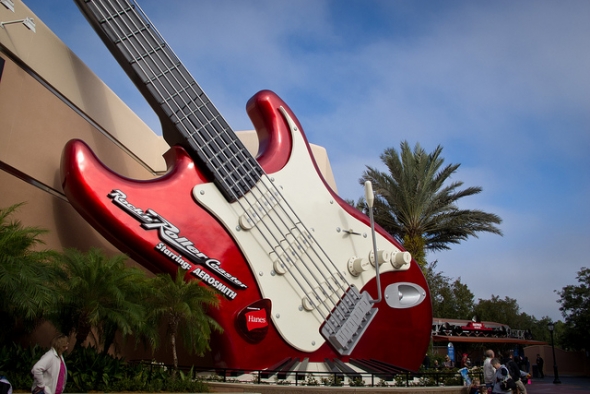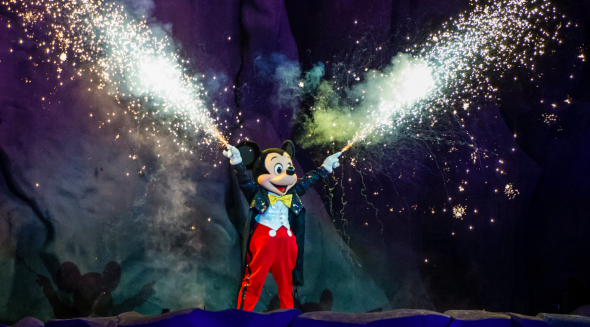The original backstory for Rock ‘n’ Roller Coaster was ominously linked to the nearby Twilight Zone Tower of Terror.
Image: HarshLight, Flickr (license)
In a resort renowned for its exceptional theming and period-specific décor, the juxtaposition of the 1930s-era Hollywood Tower Hotel alongside a more contemporary recording studio (currently feat. Aerosmith) might seem a little peculiar. Dig a little deeper into the history of that recording studio, however, and you’ll find an equally strange backstory that links the two attractions in a logical, if roundabout way.
The premise of Rock ‘n’ Roller Coaster is simple: Aerosmith has a concert booked this evening, but their rehearsal at the fictional record label G-Force Records is running behind. The only thing standing between them and thousands of their screaming fans? L.A. traffic. (The horror!) Thankfully, private limos are plentiful, they have a secret route in mind, and they’re taking you along for the ride.
According to Disney historian Jim Korkis, G-Force Records was devised by Disney Imagineers as a legendary recording studio established sometime in the 1930s. Disaster struck on Halloween night in 1939, when a reception held at the Hollywood Tower Hotel suddenly went haywire. Guests vanished, the hotel was thrown into a permanent state of disrepair, and top-shelf artists were no longer lining up to lay down their tracks at the studio.
Today, G-Force Records has recovered its reputation as one of the best in the biz. Exactly how they worked their way back from the faulty hotel elevator catastrophe is still a secret to their artists (and special backstage guests), but their new state-of-the-art facilities are impressive enough to attract names as illustrious as, well, America’s Greatest Rock and Roll Band.
Fantasmic! was intended to help promote the 1995 flick Pocahontas.
Image: Disney
Many elements of the Disney Parks are the result of years of imaginative brainstorming, collaboration, and care, but it wouldn’t be fair to dismiss outright the iconic attractions and ideas borne of pressure and tight deadlines, either. Take Fantasmic!, for example. Tasked with creating a short-lived attraction to tide guests over while they worked on Mickey’s Toontown, Disney Imagineers concocted a 22-minute show that seamlessly blended pyrotechnics, water projections, footage from beloved Disney classics, fireworks, floating barges, animatronics, and the Man himself, Mickey Mouse.
Following its premiere in May 1992, Fantasmic! was as close to an instant hit as Disney could have hoped for. It seemed like a no-brainer to bring it to Walt Disney World, where a special stage was soon constructed to accommodate the show’s large moving pieces and equipment.
In the six-year interim between its opening at Disneyland and Disney-MGM Studios, however, some changes had to be made. Disney was in the middle of an animation renaissance, one that was drawing critical acclaim and record-breaking numbers at the box office with classics like The Little Mermaid, Beauty and the Beast, Aladdin, and The Lion King. Thanks to then-CEO Michael Eisner’s philosophy of “synergy,” the Disney Parks were flooded with wave after wave of movie tie-in merchandise, special parades, and brand-new attractions.
The timing couldn’t have felt more serendipitous. The studio was ramping up to their next anticipated hit, 1995’s Pocahontas, and predicted it would eclipse the stunning $312 million The Lion King had raked in the year before. Meanwhile, Imagineers were hard at work to reconfigure Fantasmic! for Walt Disney World. Since Disney-MGM Studios didn’t have anything akin to Tom Sawyer Island or Rivers of America, a brand-new venue had to be built to accommodate such a large-scale, water-based show.
The spacious Hollywood Hills Amphitheater inspired even more changes to the show. Additional film sequences were packed into the mist projection screens; Maleficent (as a cackling, fire-spewing dragon) was no longer mobile, but confined to the 50-foot rock mountain; and most striking of all, the duel between Peter Pan and Captain Hook aboard the Sailing Ship Columbia-turned-Jolly Roger was scratched entirely. In its place: an extended acrobatic battle between the Native Americans and English colonists from Pocahontas.
What better way to advertise a hot new film than by making it an integral part of a new show? It was a bold strategy, even for Disney, and one that didn’t quite pay off when Pocahontas took in just $141 million at the box office in ‘95. By the time Fantasmic! made its East Coast debut in the fall of 1998, it was clear that Pocahontas would never reach the financial and cultural popularity of its recent predecessors.
Rather than revamp the sequence in order to promote a more popular film, though, Disney decided to preserve the lengthy (and politically problematic) scene. They couldn’t force people to the cinema, but they could still leverage their own attractions and entertainment as in-park advertising for underperforming films.



Add new comment